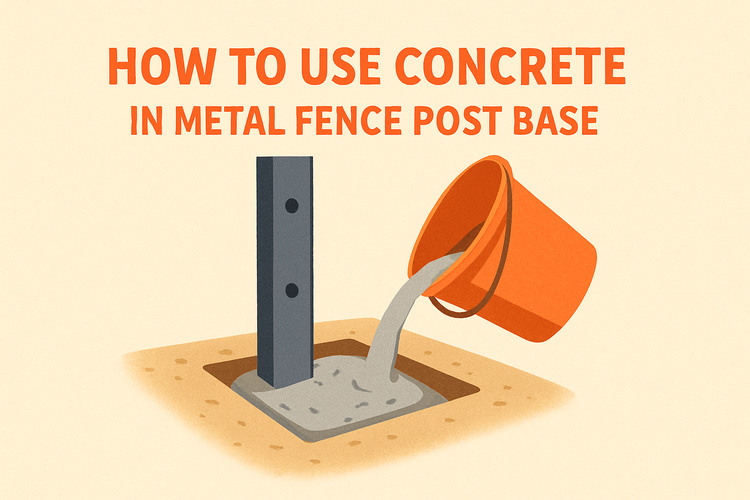How To Use Concrete In Metal Fence Post Base

Preparing the Hole and Fence Post Base
Before using concrete for a metal fence post base, the most important step is preparing the hole and base. This ensures structural stability and long-term performance.
Dig a hole that is at least one-third the height of the fence post. For example, if your post is 6 feet tall, consider a hole depth of around 2 feet. The width of the hole should be at least three times the diameter of the post. Remove any loose soil, rocks, or debris from the hole. This clean, uniform shape helps the concrete set properly and prevents water pooling, which can accelerate corrosion.
Place a gravel base of about 3 to 6 inches at the bottom of the hole. This layer helps improve drainage and prevent water from accumulating at the base of the post, reducing rust and frost heave. Set your post base on top of the gravel and ensure it's centered and level. Using a Post Base designed for metal fence posts will significantly improve durability and provide a secure anchor for your post.
Mixing and Pouring the Concrete
Mixing concrete correctly is essential to ensure a strong and durable fence post installation. Poorly mixed concrete can lead to cracking or shifting over time.
Use a quality premixed concrete, or mix your own using one part cement, two parts sand, and four parts gravel with water. The consistency should be thick but pourable, similar to peanut butter or thick porridge. You want a mix that will settle well around the post base but not be too wet that it takes long to cure or weakens during setting.
Once mixed, carefully pour the concrete around the metal post base, holding the post in place or securing it with braces. Fill the hole completely and slope the top of the concrete slightly away from the post. This technique helps water runoff and reduces the chance of water collecting next to the post. Allow the concrete to cure for a minimum of 24 to 48 hours before applying any stress or pressure to the post. For added stability in high-wind areas, consider using High Wind Ties & Timber Connectors.
Securing the Metal Post and Ensuring Level
While the concrete cures, ensuring the post remains level is vital. A leaning fence post can compromise the entire fence’s alignment.
Use a level to make sure the metal post is perfectly vertical in all directions while pouring the concrete. Before the concrete sets, brace the post using timber or a temporary frame. Even small deviations can lead to significant alignment issues across the rest of the fence. Once the concrete begins to harden, make sure there’s no shifting or tilting of the post as it will be permanent.
If you’re using a metal post base, ensure the base plate and anchor bolts are aligned properly with the post. Tighten all bolts after curing to prevent movement over time. Consider periodic checks in the weeks following the installation for any signs of settling or movement.
Weather Considerations and Curing Time
Environmental conditions, especially moisture and temperature, significantly affect concrete curing. Ideal conditions facilitate better strength and durability.
In colder weather, concrete will take longer to cure and may not gain sufficient strength if exposed to freezing temperatures too soon. In hot conditions, the concrete may dry too quickly, reducing strength and causing cracks. Use insulated blankets in colder weather or misting in hotter climates to regulate curing speed.
Standard concrete requires at least 24 to 48 hours to harden enough for light support, and up to 28 days to reach its full strength. During this time, avoid attaching fencing material or applying force to the post. Use this opportunity to plan or install other Joist Hangers or brackets if the fence is part of a larger framework structure.
Long-Term Maintenance and Durability
Once your metal post is firmly anchored, long-term maintenance will ensure it stays in great shape for years to come.
Inspect the base periodically for cracks, rust, or loose bolts. Water is the biggest enemy of metal posts, so if you notice pooling near the concrete base, consider upgrading the drainage or resealing the concrete top. Applying a rust-resistant coating to the exposed metal helps extend its lifespan and maintains the appearance of the fence.
Over time, fences may shift slightly, especially in areas with clay soils or freeze-thaw cycles. Perform semi-annual checks and tighten or adjust anchor bolts as needed. Also, examine the concrete for signs of spalling or surface breakup. If detected early, patch repairs can be done without removing the entire post. Integrating your fence project with other components like Post Base solutions ensures modular and replaceable parts, making future repairs more straightforward.
